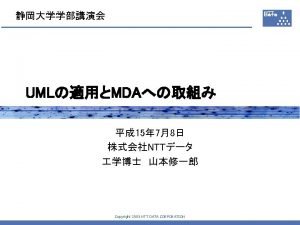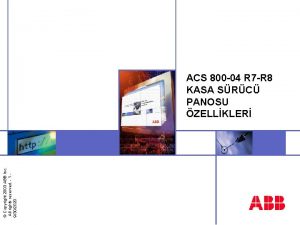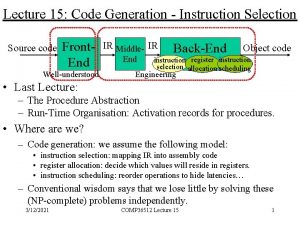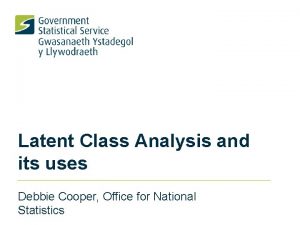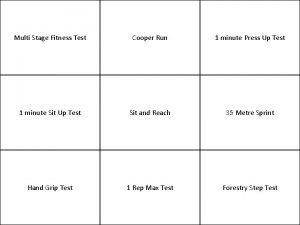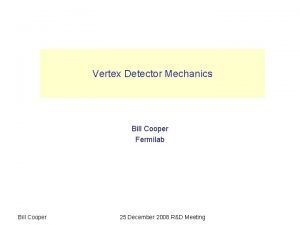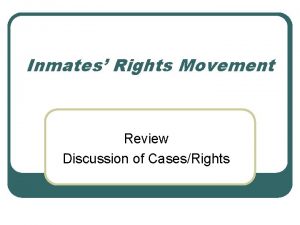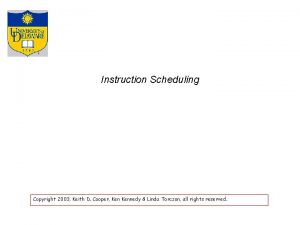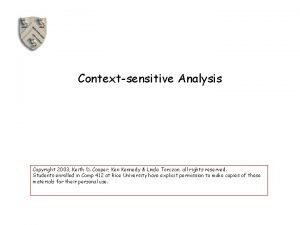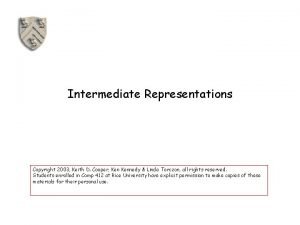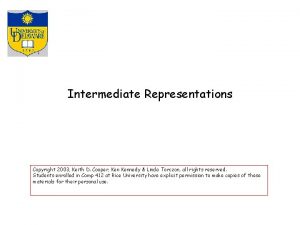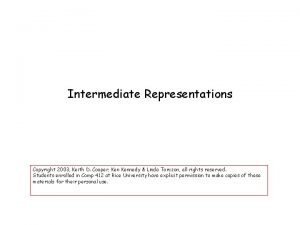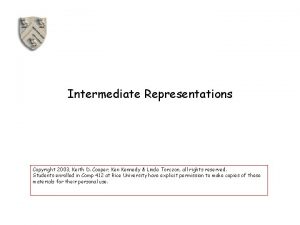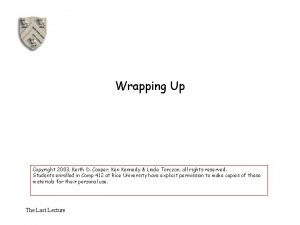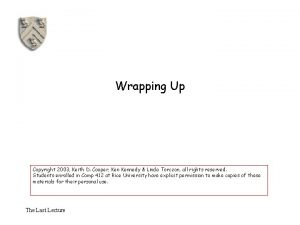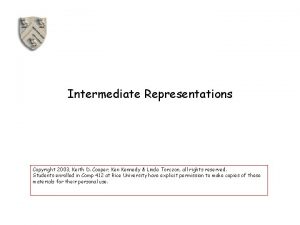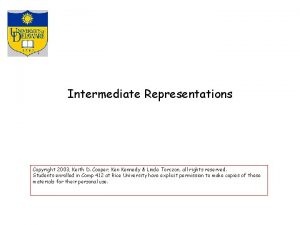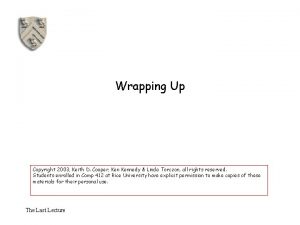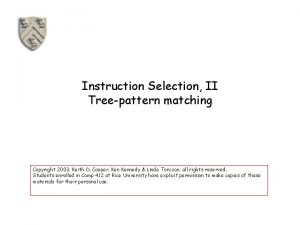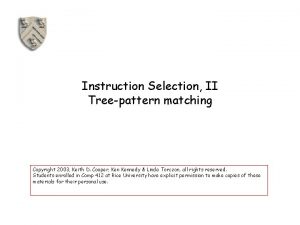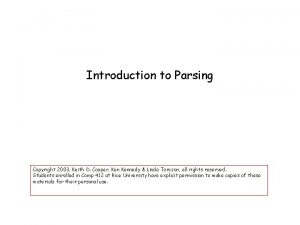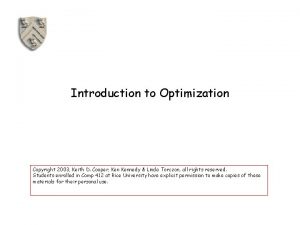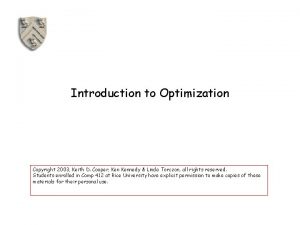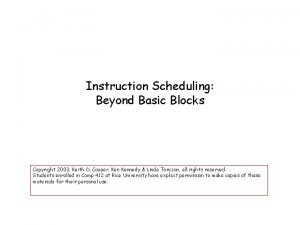Instruction Selection Copyright 2003 Keith D Cooper Kennedy























- Slides: 23

Instruction Selection Copyright 2003, Keith D. Cooper, Kennedy & Linda Torczon, all rights reserved.

The Problem Writing a compiler is a lot of work • Would like to reuse components whenever possible • Would like to automate construction of components Front End Middle End Back End Today’s lecture: Automating Instruction Selection Infrastructure • Front end construction is largely automated • Middle is largely hand crafted • (Parts of ) back end can be automated

Definitions Instruction selection • Mapping IR into assembly code • Assumes a fixed storage mapping & code shape • Combining operations, using address modes Instruction scheduling • Reordering operations to hide latencies • Assumes a fixed program (set of operations) • Changes demand for registers Register allocation • Deciding which values will reside in registers • Changes the storage mapping, may add false sharing • Concerns about placement of data & memory operations

The Problem Modern computers (still) have many ways to do anything Consider register-to-register copy in ILOC • Obvious operation is i 2 i ri rj • Many others exist ri, 0 rj sub. I ri, 0 rj lshift. I ri, 0 rj mult. I ri, 1 rj div. I ri, 1 rj rshift. I ri, 0 rj xor. I ri, 0 rj add. I or. I … and others … • Human would ignore all of these • Algorithm must look at all of them & find low-cost encoding Take context into account And ILOC is an overly-simplified case (busy functional unit? )

The Goal Want to automate generation of instruction selectors Front End Middle End Back End Infrastructure Machine description Back-end Generator Tables Pattern Matching Engine Description-based retargeting Machine description should also help with scheduling & allocation

The Big Picture Need pattern matching techniques • Must produce good code • Must run quickly (some metric for good ) A treewalk code generator runs quickly How good was the code? Tree x IDENT <a, ARP, 4> IDENT <b, ARP, 8> Treewalk Code load. I load. AO mult 4 r 5 rarp, r 5 r 6 8 r 7 rarp, r 7 r 8 r 6, r 8 r 9 Desired Code load. AI rarp, 4 r 5 load. AI rarp, 8 r 6 mult r 5, r 6 r 7

The Big Picture Need pattern matching techniques • Must produce good code • Must run quickly (some metric for good ) A treewalk code generator runs quickly How good was the code? Treewalk Code x IDENT <a, ARP, 4> IDENT <b, ARP, 8> load. I load. AO mult 4 r 5 rarp, r 5 r 6 8 r 7 rarp, r 7 r 8 r 6, r 8 r 9 Pretty easy to fix. See 1 st digression in Ch. 7 Desired Code load. AI rarp, 4 r 5 load. AI rarp, 8 r 6 mult r 5, r 6 r 7

The Big Picture Need pattern matching techniques • Must produce good code • Must run quickly (some metric for good ) A treewalk code generator runs quickly How good was the code? Treewalk Code x IDENT <a, ARP, 4> NUMBER <2> load. I load. AO load. I mult 4 r 5 rarp, r 5 r 6 2 r 7 r 6, r 7 r 8 Desired Code load. AI rarp, 4 r 5 mult. I r 5, 2 r 7

The Big Picture Need pattern matching techniques • Must produce good code • Must run quickly (some metric for good ) A treewalk code generator runs quickly How good was the code? Treewalk Code x IDENT <a, ARP, 4> NUMBER <2> load. I load. AO load. I mult Desired Code 4 r 5 rarp, r 5 r 6 2 r 7 r 6, r 7 r 8 load. AI rarp, 4 r 5 mult. I r 5, 2 r 7 Must combine these This is a nonlocal problem

The Big Picture Need pattern matching techniques • Must produce good code • Must run quickly (some metric for good ) A treewalk code generator runs quickly How good was the code? Tree x IDENT <c, @G, 4> IDENT <d, @H, 4> Treewalk Code load. I load. AO mult @G r 5 4 r 6 r 5, r 6 r 7 @H r 7 4 r 8, r 9 r 10 r 7, r 10 r 11 Desired Code load. I load. AI mult 4 r 5, @G r 6 r 5, @H r 7 r 6, r 7 r 8

The Big Picture Need pattern matching techniques • Must produce good code • Must run quickly (some metric for good ) A treewalk code generator can meet the second criteria How did it do on the first ? Tree x IDENT <c, @G, 4> IDENT <d, @H, 4> Common offset Treewalk Code load. I load. AO mult @G r 5 4 r 6 r 5, r 6 r 7 @H r 7 4 r 8, r 9 r 10 r 7, r 10 r 11 Desired Code load. I load. AI mult 4 r 5, @G r 6 r 5, @H r 7 r 6, r 7 r 8 Again, a nonlocal problem

How do we perform this kind of matching ? Tree-oriented IR suggests pattern matching on trees • Tree-patterns as input, matcher as output • Each pattern maps to a target-machine instruction sequence • Use dynamic programming or bottom-up rewrite systems Linear IR suggests using some sort of string matching • Strings as input, matcher as output • Each string maps to a target-machine instruction sequence • Use text matching or peephole matching In practice, both work well; matchers are quite different

Peephole Matching • Basic idea • Compiler can discover local improvements locally Look at a small set of adjacent operations Move a “peephole” over code & search for improvement • Classic example: store followed by load Original code Improved code store. AI r 1 rarp, 8 load. AI rarp, 8 r 15 store. AI r 1 rarp, 8 i 2 i r 15

Peephole Matching • Basic idea • Compiler can discover local improvements locally Look at a small set of adjacent operations Move a “peephole” over code & search for improvement • Classic example: store followed by load • Simple algebraic identities Original code add. I mult r 2, 0 r 7 r 4, r 7 r 10 Improved code mult r 4, r 2 r 10

Peephole Matching • Basic idea • Compiler can discover local improvements locally Look at a small set of adjacent operations Move a “peephole” over code & search for improvement • Classic example: store followed by load • Simple algebraic identities • Jump to a jump Original code jump. I L 10: jump. I L 10 L 11 Improved code L 10: jump. I L 11

Peephole Matching Implementing it • Early systems used limited set of hand-coded patterns • Window size ensured quick processing Modern peephole instruction selectors • Break problem into three tasks IR Expander IR LLIR Simplifier LLIR (Davidson) Matcher LLIR ASM

Peephole Matching Expander • Turns IR code into a low-level IR (LLIR) such as RTL • Operation-by-operation, template-driven rewriting • LLIR form includes all direct effects (e. g. , setting cc) • Significant, albeit constant, expansion of size IR Expander IR LLIR Simplifier LLIR Matcher LLIR ASM

Peephole Matching Simplifier • Looks at LLIR through window and rewrites is • Uses forward substitution, algebraic simplification, local constant propagation, and dead-effect elimination • Performs local optimization within window IR Expander IR LLIR Simplifier LLIR Matcher ASM LLIR ASM • This is the heart of the peephole system Benefit of peephole optimization shows up in this step

Peephole Matching Matcher • Compares simplified LLIR against a library of patterns • Picks low-cost pattern that captures effects • Must preserve LLIR effects, may add new ones (e. g. , set cc) • Generates the assembly code output IR Expander IR LLIR Simplifier LLIR Matcher LLIR ASM

Example Original IR Code OP Arg 1 Arg 2 Result mult 2 Y t 1 sub x t 1 w t 1 = r 14 w = r 20 Expand LLIR Code r 10 2 r 11 @y r 12 rarp + r 11 r 13 MEM(r 12) r 14 r 10 x r 13 r 15 @x r 16 rarp + r 15 r 17 MEM(r 16) r 18 r 17 - r 14 r 19 @w r 20 rarp + r 19 MEM(r 20) r 18

Example LLIR Code r 10 2 r 11 @y r 12 rarp + r 11 r 13 MEM(r 12) r 14 r 10 x r 13 r 15 @x r 16 rarp + r 15 r 17 MEM(r 16) r 18 r 17 - r 14 r 19 @w r 20 rarp + r 19 MEM(r 20) r 18 Simplify MEM(rarp LLIR Code r 13 MEM(rarp+ @y) r 14 2 x r 13 r 17 MEM(rarp + @x) r 18 r 17 - r 14 + @w) r 18

Example MEM(rarp LLIR Code r 13 MEM(rarp+ @y) r 14 2 x r 13 r 17 MEM(rarp + @x) r 18 r 17 - r 14 + @w) r 18 Match ILOC (Assembly) Code load. AI rarp, @y r 13 mult. I 2 x r 13 r 14 load. AI rarp, @x r 17 sub r 17 - r 14 r 18 store. AI r 18 rarp, @w • Introduced all memory operations & temporary names • Turned out pretty good code

Making It All Work Details • LLIR is largely machine independent • Target machine described as LLIR ASM pattern • Actual pattern matching Use a hand-coded pattern matcher Turn patterns into grammar & use LR parser (RTL) (gcc) (VPO) • Several important compilers use this technology • It seems to produce good portable instruction selectors Key strength appears to be late low-level optimization
 2008 pearson education inc
2008 pearson education inc Copyrightfrance
Copyrightfrance Copyright 2003
Copyright 2003 Copyright 2003
Copyright 2003 § 367 abgb
§ 367 abgb Individualized instruction vs differentiated instruction
Individualized instruction vs differentiated instruction Instruction selection
Instruction selection Similarities
Similarities Stabilizing selection
Stabilizing selection Procedure of pure line selection
Procedure of pure line selection K selected
K selected Logistic model of population growth
Logistic model of population growth Natural selection vs artificial selection
Natural selection vs artificial selection Two way selection and multiway selection
Two way selection and multiway selection Natural selection vs artificial selection
Natural selection vs artificial selection Balancing selection vs stabilizing selection
Balancing selection vs stabilizing selection Difference between continuous and discontinuous variation
Difference between continuous and discontinuous variation Multiway selection
Multiway selection 142 cooper river drive
142 cooper river drive Debbie cooper net worth
Debbie cooper net worth Cooper run test
Cooper run test Cooper vertex
Cooper vertex Cooper v pate
Cooper v pate Cooper v pate
Cooper v pate


